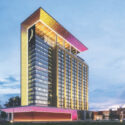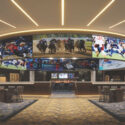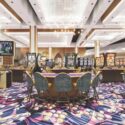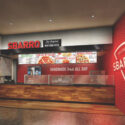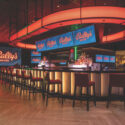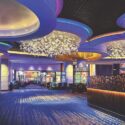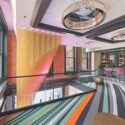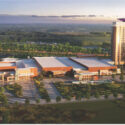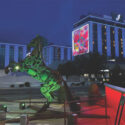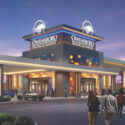A Chinese territory with a Portuguese history and a communist government has become the center of a distinctly capitalist enterprise.
xSince 2004, when the $240 million Sands Casino opened in Macau, the once-down-at-the-heels gambling enclave, an hour by ferry from Hong Kong, has become a Holy Grail for gamblers. In just a few years, the former Portuguese colony has overtaken Las Vegas as the world’s premiere gambling destination, earning more in first quarter 2008 than Vegas and Atlantic City combined.
Yet the overall aesthetic of casinos on this Chinese peninsula could not be described as fully Asian or even vaguely Pan-Asian, particularly when it comes to those built by U.S.-based operators. If anything, the glitzy, $1.8 billion Venetian Macau, to date the world’s largest casino, could have been picked up and dropped in from Las Vegas, or Disneyland for that matter. It is truly the sister property of the Las Vegas Venetian: a gilt-edged approximation of Venice complete with gondolas and a Grand Canal.
For Philip Payne, formerly the design director for the Las Vegas Sands Corp. (Macau’s first American developer and operator of both the Sands and Venetian Macao), the comparisons between Macau and Las Vegas are inevitable.
“Some of the resorts could be transplants from Vegas-for example, the Venetian (Sands) Cotai and Wynn Macau,” and there’s a very simple reason, Payne says. In the case of the Sands, the aesthetic was driven “more by the necessity for speed and economics” than a painstaking marketing plan.
A short-lived shotgun marriage between the Sands and licensed investor Galaxy Entertainment-among the first concessionaires in line when the Ho monopoly ended-had dissolved by 2002. With a timetable in place and all systems go, Sands forged ahead on its own, and remarkably, went from blueprint to grand opening in less than two years.
Despite the frenetic pace, designers “paid special attention to what would be successfully receptive to the Asian/Chinese clientele,” Payne says; design architect Paul Steelman says 98 percent of focus group participants approved the property’s ultra-modern, un-themed architecture.
The result, says Payne: “a very international, iconic type of structure unlike anything in Las Vegas” with a landmark gilded circular tower, adjoined by a boxy gaming facility that Steelman famously described as the world’s first “stadium-style casino.”
At 1 million square feet with an eye-popping six-story crystal chandelier, the Sands Macau takes the bigger-is-better mentality to an extreme, and the idea has paid off so far. Opening day in 2004 was mayhem. Ten thousand people charged the entryway in the first hour of opening; the property won back its $260 million investment in a year.
For its second project, the Sands Corp. decided not to reinvent the wheel, in part for financial reasons.
“The planning and design of the Venetian Las Vegas and the casting of the Venetian’s signature elements were already paid for,” says Payne. “There were economic advantages-and the saving of an enormous amount of time-by replicating the Venetian in Las Vegas.”
Wynn Macau-with a curved tower that instantly recalls Wynn Las Vegas-took the same approach.
“While the podium structures of Wynn Macau are project-specific, the high rise is a half-size replica of Wynn Las Vegas,” Payne observes. “The Butler Ashworth architectural plans required very little modification for the Macau high rise. Both saved considerable time and money for the operator and have worked very successfully.”
Paul Heretakis of Westar Architects says Vegas-based designers naturally lean toward elements and functional requirements that have succeeded in Sin City. And while some Asian casinos still rely on “a heavy dose of glitz and fantasia,” the emergent look reflects the kind of modernism found in Hong Kong and Shanghai: “No theming, just high quality materials used in a sophisticated and elegant manner.”
Payne agrees. “Minimalist design goes down very well in Hong Kong commercial development, but in my experience a sense of opulence and luxury is very important to the Chinese clientele in Macau.”
A general shift away from the bombastic themes of casinos like the Luxor and Excalibur in Las Vegas should be particularly important in emerging destinations. Consider Vietnam, where phases one and two of the $4.5 billion Ho Tram Strip are under way.
A project of Asian Coast Development, Ho Tram’s stated theme-if it can indeed be called a theme-is “environmental preservation and conservation highlighting the lush natural beauty of the area while showcasing Vietnamese and Asian culture.” The wow factor will be evident in two five-star hotels, a luxury spa, a Vegas-style casino, an 18-hole Greg Norman golf course and a Cirque du Soleil theater.
Back in China, bigger-is-better is rivaled by what Philip Payne calls “higher-is-better. It’s very satisfactory to look down on one’s commercial neighbor-the Galaxy Star World and Grand Lisboa in Macau are perfect expressions of this.”
If Macau’s newest casinos lack a “sense of place,” Payne attributes it to “the overwhelming preponderance of Chinese punters. It appears that they do not want Chinese interpretations, but completely embrace ‘all things American.'”
The exception might be the slot machines, which remain a hard sell among Asian gamblers. While slots account for more than 60 percent of gaming revenue in Las Vegas, it pulls in just 4 percent of the take in Macau. Though U.S. operators are confident they can acclimate Asian players to slots in time, that may be one gamble they stand to lose-and one Asian cultural preference that does not give way to Vegas sensibilities.



